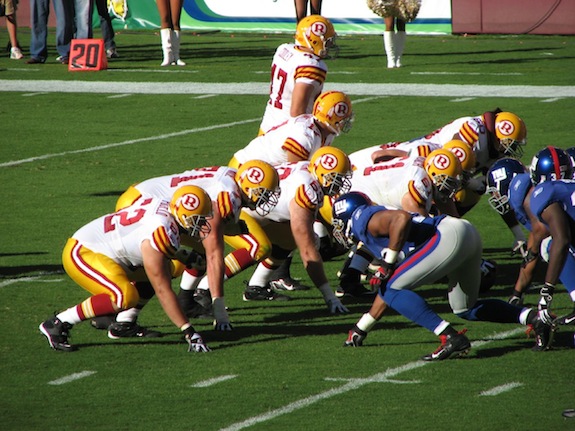New Study: NFL Players May Be More Likely to Die of Degenerative Brain Diseases
A new report links finds an increased incidence of diseases such as ALS and Alzheimer’s in retired NFL players
![]()

The frequent collisions that are a part of pro football may lead to an increased risk of Alzheimer’s and ALS, a new study finds. Photo via Wikimedia Commons/Marc Gallant
Over the past few years, the country’s favorite sport has been cast under a dark shadow. Evidence has mounted that the countless violent collisions that define football can lead to long-term degenerative brain diseases in the decades after players stop playing. New research has specifically focused on the link between repeated concussions and chronic traumatic encephalopathy (CTE), a brain disease that can cause dementia and depression—a connection grimly underscored by several widely-publicized suicides of former players who suffered from CTE.
The NFL has responded by banning helmet-to-helmet hits (which are most likely to cause a concussion), changing the rules of kickoffs (hoping to limit collisions on football’s most dangerous play) and establishing stricter guidelines for players returning to the game after suffering a concussion. This past January, football fans were cheered by a longitudinal study from the National Institute for Occupational Safety and Health that found that retired NFL players actually had a lower mortality rate than the population at large—though many critics noted that this was a poor comparison, because athletes have much better cardiovascular health than the average for the general population.
Now, just hours before the kickoff of the 2012 NFL season, the very same research team has released a study with decidedly less cheery results: Retired NFL players, they found, were three times more likely to die from diseases that damage brain cells, such as ALS (“Lou Gehrig’s Disease”) and Alzheimer’s, than the general population. These diseases are closely related to CTE and may in fact represent misdiagnosed cases of CTE because the symptoms of the various neurodegenerative diseases are so similar.
“Although our study looked at causes of death from Alzheimer’s disease and ALS as shown on death certificates, research now suggests that may have been the true primary or secondary factor in some of these deaths,” the lead author of the study, Everett J. Lehman of NIOSH, said in a press release. “A brain autopsy is necessary to diagnose CTE and distinguish it from Alzheimer’s or ALS. While CTE is a separate diagnosis, the symptoms are often similar to those found in Alzheimer’s, Parkinson’s and ALS, and can occur as the result of multiple concussions.”
For the study, published today in the journal Neurology, the researchers looked at the same 3,439 retired NFL players as before, all of whom had played at least five seasons between 1959 and 1988. Only 334 had died, much fewer than the 625 deaths expected based on mortality rates for the general population, as reported in the earlier study. However, of those 334, 13 has ALS and nine has Alzheimer’s as either the primary or contributing causes of death listed on their death certificates. This gave the retired players significantly elevated mortality rates for neurodegenerative diseases—for these two diseases in particular, rates nearly four times higher than the population of non-players matched for age and ethnicity.
The sample size for those who died from the neurodegenerative diseases is indeed very small. But the study also uncovered a telling trend that might indicate the increased mortality rates are not entirely random. The researchers divided all the players into two groups: those who play “speed” positions such as running back and wide receiver, and those who play “non-speed” positions such as offensive or defensive lineman. Speed-position players encounter much more violent collisions during the game, and speed players in the study were more than three times more likely to die from a neurodegenerative disease than the non-speed-position players.
Despite the NFL’s earnest attempts to change the game and fund research into CTE, this finding continues a troubling trend for pro football. Regardless of minor rule changes, frequent concussions are still the norm. Former players and their families are filing suit against the league for its handling of concussed players, and some prominent players have publicly stated that they’d prefer their children play other sports for safety reasons.
As the evidence linking tackle football and brain diseases continues to accumulate, a depressing truth has emerged. In the kickoff game tonight, no matter which team wins and which team is defeated, it’s the players on both sides that have the most to lose.
/https://tf-cmsv2-smithsonianmag-media.s3.amazonaws.com/accounts/headshot/joseph-stromberg-240.jpg)
/https://tf-cmsv2-smithsonianmag-media.s3.amazonaws.com/accounts/headshot/joseph-stromberg-240.jpg)